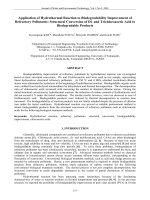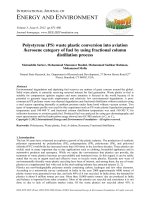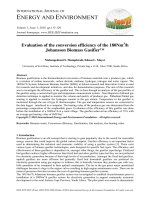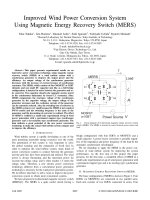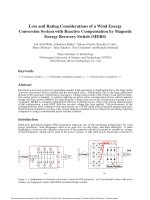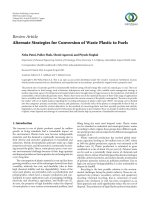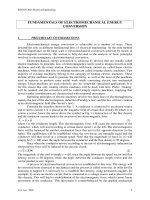solutionsmanualsignalsandsystems2nded 150324085511 conversion gate01
Bạn đang xem bản rút gọn của tài liệu. Xem và tải ngay bản đầy đủ của tài liệu tại đây (4.39 MB, 634 trang )
CHAPTER 1
1.1 to 1.41 - part of text
1.42
(a) Periodic:
Fundamental period = 0.5s
(b) Nonperiodic
(c) Periodic
Fundamental period = 3s
(d) Periodic
Fundamental period = 2 samples
(e) Nonperiodic
(f) Periodic:
Fundamental period = 10 samples
(g) Nonperiodic
(h) Nonperiodic
(i) Periodic:
Fundamental period = 1 sample
l.43
π 2
y ( t ) = 3 cos 200t + ---
6
2
π
= 9 cos 200t + ---
6
9
π
= --- cos 400t + --- 1
2
3
9
(a) DC component = --2
9
π
(b) Sinusoidal component = --- cos 400t + ---
2
3
9
Amplitude = --2
1
200
Fundamental frequency = --------- Hz
π
1.44
The RMS value of sinusoidal x(t) is A ⁄ 2 . Hence, the average power of x(t) in a 1-ohm
2
resistor is ( A ⁄ 2 ) = A2/2.
1.45
Let N denote the fundamental period of x[N]. which is defined by
2π
N = -----Ω
The average power of x[n] is therefore
N -1
1
2
P = ---- ∑ x [ n ]
N
1
= ---N
n=0
N -1
∑A
n=0
2 N -1
A
= -----N
1.46
2
2 2πn
cos ---------- + φ
N
∑ cos
n=0
2
2πn
---------- + φ
N
The energy of the raised cosine pulse is
E =
π⁄ω
1
∫–π ⁄ ω --4- ( cos ( ωt ) + 1 )
2
dt
1 π⁄ω
2
= --- ∫
( cos ( ωt ) + 2 cos ( ωt ) + 1 ) dt
2 0
1 π ⁄ ω 1
1
--- cos ( 2ωt ) + --- + 2 cos ( ωt ) + 1 dt
= --- ∫
2 0 2
2
1 3 π
= --- --- ---- = 3π ⁄ 4ω
2 2 ω
1.47
The signal x(t) is even; its total energy is therefore
5 2
E = 2 ∫ x ( t ) dt
0
2
4
5
= 2 ∫ ( 1 ) dt + 2 ∫ ( 5 – t ) dt
2
0
2
4
5
1
4
3
= 2 [ t ] t=0 + 2 – --- ( 5 – t )
3
t=4
2
26
= 8 + --- = -----3
3
1.48
(a) The differentiator output is
1
y ( t ) = –1
0
for – 5 < t < – 4
for 4 < t < 5
otherwise
(b) The energy of y(t) is
E =
–4
∫–5
5
( 1 ) dt + ∫ ( – 1 ) dt
2
2
4
= 1+1 = 2
1.49
The output of the integrator is
t
y ( t ) = A ∫ τ dτ = At
for 0 ≤ t ≤ T
0
Hence the energy of y(t) is
E =
1.50
T
∫0
2 3
A T
A t dt = ------------3
2 2
(a)
x(5t)
1.0
-1
-0.8
(b)
0
0.8
1
t
25
t
x(0.2t)
1.0
-25
-20
0
20
3
1.51
x(10t - 5)
1.0
0
1.52
0.1
0.5
0.9
1.0
t
(a)
x(t)
1
-1
1
2
t
3
-1
y(t - 1)
-1
1
2
t
3
-1
x(t)y(t - 1)
1
1
-1
2
t
3
-1
4
1.52
(b)
x(t + 1)
x(t - 1)
1
1
-1
1
2
3
4
t
-1
y(-t)y(-t)
1
-2
-1
1
2
3
4
3
4
t
-1
x(t - 1)y(-t)
1
t
-2
-1
1
2
-1
1.52
(c)
-2
-1
1
2
3
3
4
3
4
t
-1
-2
-1
1
2
t
x(t + 1)y(t - 2)
-2
-1
1
2
5
t
1.52
(d)
x(t)
1
-3
-2
-1
1
2
t
3
-1
y(1/2t + 1)
6
-5
-4 -3
-2
-1
1
2
4
6
t
-1.0
x(t - 1)y(-t)
1
t
-3
1.52
-2
-1
-1
1
2
3
(e)
x(t)
1
-4
-3
-2
-1
1
2
3
t
-1
y(2 - t)
1
-4
-3
-2
2
3
t
-1
x(t)y(2 - t)
-1
1
2
3
-1
6
t
1.52
(f)
x(t)
1
-2
-1
1
t
2
-1
y(t/2 + 1)
1.0
-5
-3
-2
-1
-6
1
1
2
t
3
-1.0
x(2t)y(1/2t + 1)
+1
-0.5
1
-1
2
t
-1
1.52
(g)
x(4 - t)
1
-7
-6
-5 -4
-3
t
-2
-1
y(t)
-2
-1
1
2
4
t
x(4 - t)y(t) = 0
-3
-2
-1
1
2
3
7
t
1.53
We may represent x(t) as the superposition of 4 rectangular pulses as follows:
g1(t)
1
1
2
11
2
3
4
t
g2(t)
1
3
4
t
g3(t)
1
1
2
3
4
t
g4(t)
1
1
2
3
4
t
0
To generate g1(t) from the prescribed g(t), we let
g 1 ( t ) = g ( at – b )
where a and b are to be determined. The width of pulse g(t) is 2, whereas the width of
pulse g1(t) is 4. We therefore need to expand g(t) by a factor of 2, which, in turn, requires
that we choose
1
a = --2
The mid-point of g(t) is at t = 0, whereas the mid-point of g1(t) is at t = 2. Hence, we must
choose b to satisfy the condition
a(2) – b = 0
or
1
b = 2a = 2 --- = 1
2
1
Hence, g 1 ( t ) = g --- t – 1
2
Proceeding in a similar manner, we find that
2 5
g 2 ( t ) = g --- t – ---
3 3
g3 ( t ) = g ( t – 3 )
g 4 ( t ) = g ( 2t – 7 )
Accordingly, we may express the staircase signal x(t) in terms of the rectangular pulse g(t)
as follows:
8
2 5
1
x ( t ) = g --- t – 1 + g --- t – --- + g ( t – 3 ) + g ( 2t – 7 )
3 3
2
1.54
(a)
x(t) = u(t) - u(t - 2)
0
1
t
2
(b)
x(t) = u(t + 1) - 2u(t) + u(t - 1)
-2
0
1
2
-1
t
3
-1
(c)
x(t) = -u(t + 3) + 2u(t +1) -2u(t - 1) + u(t - 3)
1
-3
2
3
t
0
-1
(d)
x(t) = r(t + 1) - r(t) + r(t - 2)
1
-2
-1
0
1
2
t
3
(e)
x(t) = r(t + 2) - r(t + 1) - r(t - 1)+ r(t - 2)
1
-3
-2
-1
0
1
t
2
9
1.55
We may generate x(t) as the superposition of 3 rectangular pulses as follows:
g1(t)
1
-4
-2
0
2
4
2
4
t
g2(t)
1
-4
-2
0
t
g3(t)
1
-4
-2
0
2
4
t
All three pulses, g1(t), g2(t), and g3(t), are symmetrically positioned around the origin:
1. g1(t) is exactly the same as g(t).
2. g2(t) is an expanded version of g(t) by a factor of 3.
3. g3(t) is an expanded version of g(t) by a factor of 4.
Hence, it follows that
g1 ( t ) = g ( t )
1
g 2 ( t ) = g --- t
3
1
g 3 ( t ) = g --- t
4
That is,
1
1
x ( t ) = g ( t ) + g --- t + g --- t
3
4
1.56
(a)
x[2n]
o 2
o
o
0
-1
1
n
(b)
x[3n - 1]
o
2
o1
o
-1
0
1
10
n
1.56
(c)
y[1 - n]
o1
o
o
o
o
-4
-3
-2
-1
0
-1
o
1
2
3
4
5
o
o
o
o
2
3
4
5
o
o
o
o
n
(d)
y[2 - 2n]
o
o
-3
-2
o
o1
o
1
-1
-1
n
(e)
x[n - 2] + y[n + 2]
o
o
4
o
o3
o
2 o
o
1
-7
o
-6
o
-5
o
-4
o
-3
o
-2
-1
0
1
2
3
4
o
o
o
5
6
7
8
o
o
o
5
6
7
n
o
(f)
x[2n] + y[n - 4]
o
-5
-4
-3
1 o
-2
2
3
-1
o
o
o
o
o -1
11
o
o
o
4
n
1.56
(g)
x[n + 2]y[n - 2]
o
-5
-4
-3
-2
o
-1
1
o
n
1
o
o
o
o
o2
3 o
o
(h)
x[3 - n]y[-n]
3
o
o
2
o
-2
o
o
1
o
-3
o
o
-1
1
2
o
7
o
8
n
3
4
5
6
3
4
o
5
o
6
o
n
4
o
5
o
6
o
n
(i)
x[-n] y[-n]
o
3
o
2
o
o
-5
o
-4
-3
-2
-1
1
1
o
2
-1 o
-2
o
-3
o
(j)
x[n]y[-2-n]
o
3
2
1
o
-6
o
-5
o
-4
-2
o
-1
1
o
2
3
-3
o
-1 o
-2
-3
12
o
o
1.56
(k)
x[n + 2]y[6-n]
3
o
2
o 1
-8
o
-7
o
-6
o
-5
-4
-3
o
o
o
1.57
o
-2
-1
1
o
2
o
3
o
4
o
5
o
6
n
-1
-2
-3
(a) Periodic
Fundamental period = 15 samples
(b) Periodic
Fundamental period = 30 samples
(c) Nonperiodic
(d) Periodic
Fundamental period = 2 samples
(e) Nonperiodic
(f) Nonperiodic
(g) Periodic
Fundamental period = 2π seconds
(h) Nonperiodic
(i) Periodic
Fundamental period = 15 samples
1.58
The fundamental period of the sinusoidal signal x[n] is N = 10. Hence the angular
frequency of x[n] is
2πm
m: integer
Ω = ----------N
The smallest value of Ω is attained with m = 1. Hence,
2π
π
Ω = ------ = --- radians/cycle
10
5
13
1.59
The amplitude of complex signal x(t) is defined by
2
2
xR( t ) + xI ( t ) =
2
2
2
2
A cos ( ωt + φ ) + A sin ( ωt + φ )
2
2
= A cos ( ωt + φ ) + sin ( ωt + φ )
= A
1.60
Real part of x(t) is
αt
Re { x ( t ) } = Ae cos ( ωt )
Imaginary part of x(t) is
αt
Im { x ( t ) } = Ae sin ( ωt )
1.61
We are given
x(t ) =
t
∆
∆
--- for – --- ≤ t ≤ --2
2
∆
∆
1 for t ≥ --2
∆
2 for t < – --2
The waveform of x(t) is as follows
x(t)
1
1
2
-∆/2
∆/2
0
- 12
14
t
The output of a differentiator in response to x(t) has the corresponding waveform:
y(t)
1 δ(t - 1 )
2
2
1/∆
t
∆/2
0
-∆/2
1 δ(t + ∆ )
2
2
y(t) consists of the following components:
1. Rectangular pulse of duration ∆ and amplitude 1/∆ centred on the origin; the area
under this pulse is unity.
2. An impulse of strength 1/2 at t = ∆/2.
3. An impulse of strength -1/2 at t = -∆/2.
As the duration ∆ is permitted to approach zero, the impulses (1/2)δ(t-∆/2) and
-(1/2)δ(t+∆/2) coincide and therefore cancel each other. At the same time, the rectangular
pulse of unit area (i.e., component 1) approaches a unit impulse at t = 0. We may thus state
that in the limit:
d
lim y ( t ) = lim ----- x ( t )
∆→0
∆ → 0 dt
= δ(t )
1.62
We are given a triangular pulse of total duration ∆ and unit area, which is symmetrical
about the origin:
x(t)
2/∆
slope = -4/∆2
slope = 4/∆2
area = 1
-∆/2
∆/2
0
15
t
(a) Applying x(t) to a differentiator, we get an output y(t) depicted as follows:
y(t)
4/∆2
area = 2/∆
∆/2
t
-∆/2
area = 2/∆
-4/∆2
(b) As the triangular pulse duration ∆ approaches zero, the differentiator output
approaches the combination of two impulse functions described as follows:
• An impulse of positive infinite strength at t = 0-.
• An impulse of negative infinite strength at t = 0+.
(c) The total area under the differentiator output y(t) is equal to (2/∆) + (-2/∆) = 0.
In light of the results presented in parts (a), (b), and (c) of this problem, we may now make
the following statement:
When the unit impulse δ(t) is differentiated with respect to time t, the resulting output
consists of a pair of impulses located at t = 0- and t = 0+, whose respective strengths
are +∞ and -∞.
1.63
From Fig. P.1.63 we observe the following:
x1 ( t ) = x2 ( t ) = x3 ( t ) = x ( t )
x4 ( t ) = y3 ( t )
Hence, we may write
y 1 ( t ) = x ( t )x ( t – 1 )
(1)
y2 ( t ) = x ( t )
(2)
y 4 ( t ) = cos ( y 3 ( t ) ) = cos ( 1 + 2x ( t ) )
(3)
The overall system output is
y ( t ) = y1 ( t ) + y2 ( t ) – y4 ( t )
(4)
Substituting Eqs. (1) to (3) into (4):
y ( t ) = x ( t )x ( t – 1 ) + x ( t ) – cos ( 1 + 2x ( t ) )
(5)
Equation (5) describes the operator H that defines the output y(t) in terms of the input x(t).
16
1.64
(a)
(b)
(c)
(d)
(e)
(f)
(g)
(h)
(i)
(j)
(k)
(l)
1.65
Memoryless
✓
✓
✓
x
x
x
✓
x
x
✓
✓
✓
Stable
✓
✓
✓
✓
✓
✓
✓
✓
✓
✓
✓
✓
Causal
✓
✓
✓
✓
x
✓
x
✓
x
✓
✓
✓
Linear
x
✓
x
✓
✓
✓
x
✓
✓
✓
✓
x
Time-invariant
✓
✓
✓
✓
✓
✓
✓
✓
✓
✓
✓
✓
We are given
y [ n ] = a0 x [ n ] + a1 x [ n – 1 ] + a2 x [ n – 2 ] + a3 x [ n – 3 ]
Let
k
S { x(n)} = x(n – k )
We may then rewrite Eq. (1) in the equivalent form
1
2
3
y [ n ] = a0 x [ n ] + a1 S { x [ n ] } + a2 S { x [ n ] } + a3 S { x [ n ] }
1
2
3
= ( a0 + a1 S + a2 S + a3 S ) { x [ n ] }
= H { x[n]}
where
1
2
H = a0 + a1 S + a2 S + a3 S
.
3
.
(a) Cascade implementation of operator H:
x[n]
a0
S
S
.
S
a2
a1
a3
Σ
y[n]
17
(1)
(b) Parallel implementation of operator H:
x[n]
1.66
a0
..
.
S1
a1
Σ
S2
a2
S3
a3
y[n]
Using the given input-output relation:
y [ n ] = a0 x [ n ] + a1 x [ n – 1 ] + a2 x [ n – 2 ] + a3 x [ n – 3 ]
we may write
y [ n ] = a0 x [ n ] + a1 x [ n – 1 ] + a2 x [ n – 2 ] + a3 x [ n – 3 ]
≤ a0 x [ n ] + a1 x [ n – 1 ] + a2 x [ n – 2 ] + a3 x [ n – 3 ]
≤ a0 M x + a1 M x + a2 M x + a3 M x
= ( a 0 + a 1 + a 2 + a 3 )M x
where M x = x ( n ) . Hence, provided that Mx is finite, the absolute value of the output
will always be finite. This assumes that the coefficients a0, a1, a2, a3 have finite values of
their own. It follows therefore that the system described by the operator H of Problem 1.65
is stable.
1.67
The memory of the discrete-time described in Problem 1.65 extends 3 time units into the
past.
1.68
It is indeed possible for a noncausal system to possess memory. Consider, for example, the
system illustrated below:
.
x(n + k)
ak
.
x[n]
Sk
x(n - l)
Sl
a0
al
Σ
y[n]
l{x[n]}
= x[n - l], we have the input-output relation
That is, with S
y [ n ] = a0 x [ n ] + ak x [ n + k ] + al x [ n – l ]
This system is noncausal by virtue of the term akx[n + k]. The system has memory by
virtue of the term alx[n - l].
18
1.69
(a) The operator H relating the output y[n] to the input x[n] is
1
H = 1+S +S
where
2
k
S { x[n]} = x[n – k ]
for integer k
(b) The inverse operator Hinvis correspondingly defined by
inv
1
H
= -------------------------1
2
1+S +S
Cascade implementation of the operator H is described in Fig. 1. Correspondingly,
feedback implementation of the inverse operator Hinvis described in Fig. 2
x[n]
.
.
S
S
Σ
Fig. 1
Operator H
y[n]
y[n]
+
Σ
.
S
.
x[n]
S
Fig. 2
Inverse Operator Hinv
Figure 2 follows directly from the relation:
x[n] = y[n] – x[n – 1] – x[n – 2]
1.70
For the discrete-time system (i.e., the operator H) described in Problem 1.65 to be timeinvariant, the following relation must hold
n
0
S H = HS
where
n0
for integer n0
(1)
n
S 0 { x [ n ] } = x [ n – n0 ]
and
1
2
H = 1+S +S
We first note that
n
n
1
n
n +1
2
S 0H = S 0(1 + S + S )
= S 0+S 0
Next we note that
HS
n0
1
+S
2
= (1 + S + S )S
n0 + 2
(2)
n0
19
n
1+n
2+n
0
0
= S 0+S
+S
(3)
From Eqs. (2) and (3) we immediately see that Eq. (1) is indeed satisfied. Hence, the
system described in Problem 1.65 is time-invariant.
1.71
(a) It is indeed possible for a time-variant system to be linear.
(b) Consider, for example, the resistance-capacitance circuit where the resistive
component is time variant, as described here:
R(t)
i(t)
v1(t)
+
C
.
.
o+
v2(t)
o-
This circuit, consisting of the series combination of the resistor R(t) and capacitor C, is
time variant because of R(t).
The input of the circuit, v1(t), is defined in terms of the output v2(t) by
dv 2 ( t )
v 1 ( t ) = R ( t )C --------------- + v 2 ( t )
dt
Doubling the input v1(t) results in doubling the output v2(t). Hence, the property of
homogeneity is satisfied.
Moreover, if
N
v1 ( t ) =
∑ v1, k ( t )
k=1
then
N
v2 ( t ) =
∑ v2, k ( t )
k=1
where
dv 2, k ( t )
v 1, k ( t ) = R ( t )C ------------------- + v 2, k ( t ) ,
dt
k = 1,2,...,N
Hence, the property of superposition is also satisfied.
We therefore conclude that the time-varying circuit of Fig. P1.71 is indeed linear.
1.72
We are given the pth power law device:
p
y(t ) = x (t )
(1)
20
Let y1(t) and y2(t) be the outputs of this system produced by the inputs x1(t) and x2(t),
respectively. Let x(t) = x1(t) + x2(t), and let y(t) be the corresponding output. We then note
that
p
for p ≠ 0, 1
y ( t ) = ( x1 ( t ) + x2 ( t ) ) ≠ y1 ( t ) + y2 ( t )
Hence the system described by Eq. (1) is nonlinear.
1.73
Consider a discrete-time system described by the operator H1:
H 1 : y [ n ] = a0 x [ n ] + ak x [ n – k ]
This system is both linear and time invariant. Consider another discrete-time system
described by the operator H2:
H 2 : y [ n ] = b0 x [ n ] + bk x [ n + k ]
which is also both linear and time invariant. The system H1 is causal, but the second
system H2 is noncausal.
1.74
The system configuration shown in Fig. 1.56(a) is simpler than the system configuration
shown in Fig. 1.56(b). They both involve the same number of multipliers and summer.
however, Fig. 1.56(b) requires N replicas of the operator H, whereas Fig. 1.56(a) requires a
single operator H for its implementation.
1.75
(a) All three systems
• have memory because of an integrating action performed on the input,
• are causal because (in each case) the output does not appear before the input, and
• are time-invariant.
(b) H1 is noncausal because the output appears before the input. The input-output relation
of H1 is representative of a differentiating action, which by itself is memoryless.
However, the duration of the output is twice as long as that of the input. This suggests
that H1 may consist of a differentiator in parallel with a storage device, followed by a
combiner. On this basis, H1 may be viewed as a time-invariant system with memory.
System H2 is causal because the output does not appear before the input. The duration
of the output is longer than that of the input. This suggests that H2 must have memory.
It is time-invariant.
System H3 is noncausal because the output appears before the input. Part of the output,
extending from t = -1 to t = +1, is due to a differentiating action performed on the
input; this action is memoryless. The rectangular pulse, appearing in the output from
t = +1 to t = +3, may be due to a pulse generator that is triggered by the termination of
the input. On this basis, H3 would have to be viewed as time-varying.
21
Finally, the output of H4 is exactly the same as the input, except for an attenuation by a
factor of 1/2. Hence, H4 is a causal, memoryless, and time-invariant system.
1.76
H1 is representative of an integrator, and therefore has memory. It is causal because the
output does not appear before the input. It is time-invariant.
H2 is noncausal because the output appears at t = 0, one time unit before the delayed input
at t = +1. It has memory because of the integrating action performed on the input. But,
how do we explain the constant level of +1 at the front end of the output, extending from
t = 0 to t = +1? Since the system is noncausal, and therefore operating in a non real-time
fashion, this constant level of duration 1 time unit may be inserted into the output by
artificial means. On this basis, H2 may be viewed as time-varying.
H3 is causal because the output does not appear before the input. It has memory because of
the integrating action performed on the input from t = 1 to t = 2. The constant level
appearing at the back end of the output, from t = 2 to t = 3, may be explained by the
presence of a strong device connected in parallel with the integrator. On this basis, H3 is
time-invariant.
Consider next the input x(t) depicted in Fig. P1.76b. This input may be decomposed into
the sum of two rectangular pulses, as shown here:
xA(t)
x(t)
2
2
1
1
0
1
2
t
xB(t)
+
0
1
2
2
1
t
0
1
2
t
2
t
Response of H1 to x(t):
y1,A(t)
y1,B(t)
2
+
1
0
1
2
t
y1(t)
2
2
1
1
0
1
2
22
t
0
1
Response of H2 to x(t):
y2,A(t)
2
2
+
1
1
-1
y2(t)
y2,B(t)
1
2
t
0
-1
2
0
-1
2
t
1
-1 0
1
t
-1
-2
-2
The rectangular pulse of unit amplitude and unit duration at the front end of y2(t) is
inserted in an off-line manner by artificial means
Response of H3 to x(t):
y3,A(t)
2
+
1
0
1.77
1
y3(t)
y3,B(t)
2
3
2
2
1
1
t
0
1
2
3
t
0
1
2
3
t
(a) The response of the LTI discrete-time system to the input δ[n-1] is as follows:
y[n]
o
2
o
1
o
4
2
o
-1
1
-1
5
o
o
n
3
o
(b) The response of the system to the input 2δ[n] - δ[n - 2] is as follows
y[n]
4o
3
2
o
1
o
-2
1
o
-1 0
-1
-2
4
o
2
3
o
o
5
6
o
o
23
n
(c) The input given in Fig. P1.77b may be decomposed into the sum of 3 impulse
functions: δ[n + 1], -δ[n], and 2δ[n - 1]. The response of the system to these three
components is given in the following table:
Time
n
δ[n + 1]
-1
0
1
2
3
+2
-1
+1
-δ[n]
2δ[n - 1]
-2
+1
-1
+4
-2
+2
Total
response
+1
-3
+6
-3
2
Thus, the total response y[n] of the system is as shown here:
y[n]
o
6
5
4
3
o
2
o 1
o
-3
2
o
-2
0
-1
1
4
3
5
6
o
o
o
-1
-2
-3
o
o
Advanced Problems
1.78
(a) The energy of the signal x(t) is defined by
E =
∞
∫–∞ x
2
( t ) dt
Substituting
x ( t ) = xe ( t ) + xo ( t )
into this formula yields
E =
∞
∫–∞ [ xe ( t ) + xo ( t ) ]
∞
2
dt
2
=
∫–∞ [ xe ( t ) + xo ( t ) + 2xe ( t )xo ( t ) ]
=
∫–∞ xe ( t ) dt + ∫–∞ xo ( t ) dt + 2 ∫–∞ xe ( t )xo ( t ) dt
∞
2
2
2
∞
2
∞
24
dt
(1)
With xe(t) even and xo(t) odd, it follows that the product xe(t)xo(t) is odd, as shown by
x e ( – t )x o ( – t ) = x e ( t ) [ – x o ( t ) ]
= – x e ( t )x o ( t )
Hence,
∞
∫–∞
( x e ( t )x o ( t ) ) dt =
0
∫–∞
∞
x e ( t )x o ( t ) dt + ∫ x e ( t )x o ( t ) dt
0
∞
0
∫–∞ ( – xe ( t )xo ( t ) ) ( –dt ) + ∫0 ( xe ( t )xo ( t ) ) dt
=
∞
∞
0
0
= – ∫ x e ( t )x o ( t ) dt + ∫ x e ( t )x o ( t ) dt
= 0
Accordingly, Eq. (1) reduces to
E =
∞
∫–∞
∞
x e ( t ) dt + ∫
2
2
–∞
x o ( t ) dt
(b) For a discrete-time signal x[n], – ∞ ≤ n ≤ ∞ , we may similarly write
∞
E =
∑x
2
[n]
n=-∞
∞
=
∑ [ xe [ n ] + xo [ n ] ]
n=-∞
∞
=
∑
∞
2
xe [ n ]
∑
+
n=-∞
2
2
2
xo [ n ]
∞
+2
n=-∞
∑ xe [ n ]xo [ n ]
n=-∞
With
x e [ – n ]x o [ – n ] = – x e [ n ]x o [ n ]
it follows that
∞
∑ xe [ n ]xo [ n ]
=
n=-∞
=
0
∞
n=-∞
0
n=-0
∑ xe [ n ]xo [ n ] + ∑ xe [ n ]xo [ n ]
∞
∑ xe [ –n ]xo [ –n ] + ∑ xe [ n ]xo [ n ]
n=-∞
0
= – ∑ x e [ n ]x o [ n ] +
n=∞
n=-0
∞
∑ xe [ n ]xo [ n ]
n=0
= 0
25
(2)
